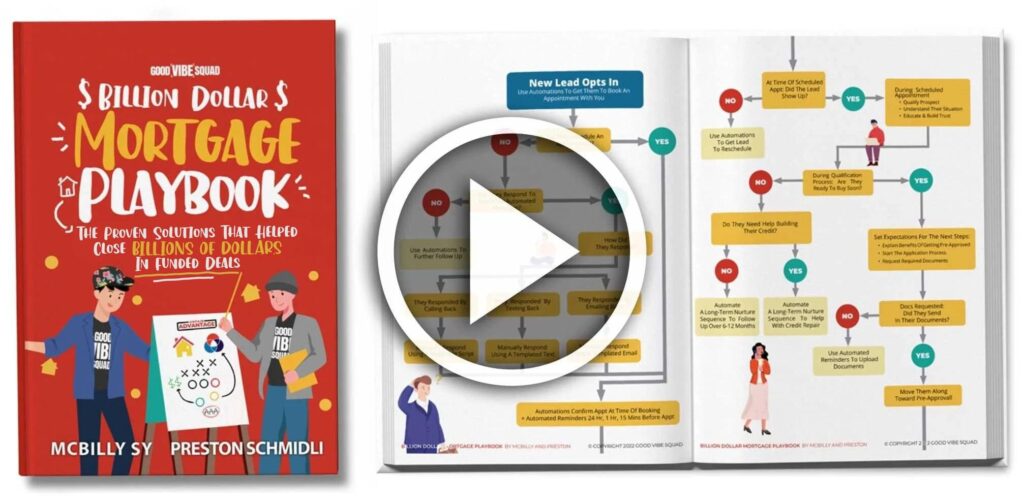Get Our Billion Dollar Mortgage Playbook
Get the proven strategies that helped close Billions of dollars in funded deals!
As a mortgage professional, you know how important it is to connect with your clients. Social media has transformed every industry and the way we communicate with each other. This article highlights how to leverage social media to optimize your business and relationships. Whether it be to attract and engage clients, build brand awareness, provide excellent customer service, gain market insights, or measure the effectiveness of their efforts, these statistics provide invaluable insights for loan officers.
Every mortgage loan officer should know which social media platforms are growing the fastest, how large their user base is, and how to get the most engagement out of their content in order to grow their pipeline and close more deals.
Key Takeaways
- Social media is a valuable tool for mortgage professionals to connect with clients, build brand awareness, and provide customer service.
- The number of social media users keeps going up every year, indicating a growing potential market for loan officers.
- Keeping yourself updated with current statistics and trends in the social media industry will catapult you to success.
Most Important Social Media Statistics for LOs
1. Amount of Social Media Users
In 2022, 90% of people in the United States were using social media, which is a bit more than the 88% who were using it in 2021. It’s expected that by 2027, nearly 95% of all people in the U.S. will be active on social media. The U.S. has the third biggest group of social media users in the world, with over 302 million people using social networks in 2022. (Statista, 2024)
2. How Fast It’s Growing
The number of people using social media in the U.S. is expected to keep growing from 2024 to 2028, with an estimated increase of about 22.8 million users (a 7.4% rise). This means we could see around 331.09 million social media users by 2028, reaching a new high after five years of consistent growth. The number of social media users has been on a steady rise in recent years. (Statista, 2024)
3. Counting the Hours
According to DataReportal, recent data from GWI shows that the average internet user of working age now spends over 2.5 hours each day on social media platforms. This is a 2% increase (or 3 more minutes) compared to the daily average at the start of 2022. (DataReportal, 2024)
4. Top Activities
Based on a survey of the most common social media activities, U.S. consumers have identified “liking posts by other users” and “sending private messages” as their top two activities. The survey was conducted online and involved 60,054 respondents in the United States in 2024. (Statista, 2024)
5. Taking Accountability
A significant 81% of people say that social media has made businesses more accountable. Brands are now expected to meet higher standards than even friends, family, and politicians. While this can be challenging for businesses, it also creates opportunities for those that can use transparent and genuine social strategies to build strong relationships with customers. (SproutSocial, 2024)
6. Complexity in Numbers
On average, people around the world have 8.4 social media accounts. Americans are close behind with 7.1 accounts, which is between the high of 11.5 accounts in India and the more modest 3.8 in Japan. These numbers show the wide and complex range of platforms that social media marketers have to navigate.
94% of marketers use Facebook. Instagram comes in second with 76%, followed by LinkedIn with 59% and Twitter with 53%. (Social Media Examiner, 2024)
How Has the Evolution of Social Media Impacted Loan Officers?
In the digital age, the way we communicate and conduct business has undergone a significant transformation. A key driver of this change has been the evolution of social media. From Facebook to LinkedIn, Instagram to Twitter, these platforms have reshaped the landscape of numerous industries, including the mortgage sector.
The “AHA!” Moment
Social media began as a way for individuals to connect with each other, share experiences, and keep in touch, regardless of distance. However, it didn’t take long for businesses to recognize the potential of these platforms as powerful marketing tools. The ability to reach a vast audience, interact with potential clients, and enhance brand visibility made social media an essential asset for businesses, including those in the mortgage industry.
Transforming Client Acquisition and Engagement
Before the advent of social media, loan officers primarily relied on traditional methods of client acquisition, such as referrals, cold calling, and direct mail. However, social media has revolutionized this process. Platforms like Facebook and LinkedIn provide loan officers with access to a vast pool of potential clients. By sharing valuable content, engaging with users, and responding promptly to inquiries, loan officers can attract new clients and build lasting relationships.
Building Trust and Credibility
Trust and credibility are crucial in the mortgage industry. Social media provides loan officers with a platform to establish themselves as knowledgeable and reliable professionals. Regularly sharing informative content about loans, finance, and the housing market can help loan officers demonstrate their expertise and build trust among potential clients. Client testimonials and reviews shared on social media further bolster this trust, influencing potential clients’ decisions.
Real-Time Customer Service
The immediacy of social media has revolutionized customer service. Clients expect quick responses to their inquiries and concerns, and social media allows loan officers to meet these expectations. Whether it’s answering a question about loan processes or providing updates on loan status, social media enables loan officers to deliver timely and efficient customer service.
Harnessing Market Insights
Social media is not just a platform for communication—it’s also a rich source of market insights. By monitoring social media trends, discussions, and client feedback, loan officers can gain a deeper understanding of their clients’ needs, preferences, and pain points. These insights can guide them in tailoring their services, improving client satisfaction, and staying ahead of market trends.
The Rise of Influencer Partnerships
The rise of influencer marketing is a notable trend in the evolution of social media. Loan officers can capitalize on this trend by partnering with financial influencers. These partnerships can help loan officers reach a wider audience, enhance their credibility, and attract more clients.
The Importance of ROI Tracking
Despite the numerous benefits of social media, it’s important for loan officers to track the return on investment (ROI) of their social media efforts. With sophisticated analytics tools, loan officers can measure the effectiveness of their social media strategies, understand what’s working and what’s not, and make logical, data-driven decisions to optimize their results.
Overview of the Most Common Social Media Platforms for LOs
Loan officers usually use a variety of social media platforms to reach out to potential clients, share valuable content, and build their professional networks. Here are some of the most commonly used platforms:
LinkedIn has seen steady growth in the United States, with more than 199 million members in the US alone. As a professional networking platform, LinkedIn is a crucial tool for loan officers. (SproutSocial, 2024)
With its vast user base, Facebook is a great platform for reaching a wide audience. As of early 2024, Facebook had 246.0 million users in the United States, which accounts for approximately 72.5% of the total population. (Statista, 2024)
Twitter is an excellent platform for sharing quick updates, news, and tips. According to Hootsuite, 61.2% of people say that Twitter is where they go to stay up to date with news and events. (Hootsuite, 2024)
In the United States, Instagram had a user base of approximately 246.0 million users as of early 2024. Known for its focus on photo and video sharing that allows users to capture, edit, and share visual content, as well as interact with others through likes, comments, direct messages, and story sharing. Instagram’s popularity is particularly strong among younger demographics, with a significant portion of Gen Z and millennials actively using the platform. (Statista, 2024)
TikTok
TikTok has experienced tremendous growth in the United States and surpassed 100 million monthly users in the country. The platform has gained popularity among younger generations, particularly Gen Z, and has become one of the leading social networks in terms of user count. (Statista, 2024)
Youtube
The beloved video-sharing platform where users can upload, view, rate, share, comment on videos, and subscribe to other users’ channels. Almost 73% of the entire US population aged 15+ are users, rising to 77% among 15-35 year-olds. (Backlinko, 2024)
Remember: Each of these platforms offers unique features and benefits, and the best choice depends on the loan officer’s specific goals, target audience, and content strategy. It’s also important to be reminded that successful social media marketing involves consistent engagement and providing valuable content, regardless of the platform used.
How to Optimize Each Social Media Platform
As a professional networking platform, LinkedIn is a must-use for loan officers. It’s a great place to share industry knowledge, connect with potential clients, and network with other professionals in the financial sector. LinkedIn’s publishing platform also provides an opportunity to share longer-form content, such as articles and thought leadership pieces.
Facebook remains the most significant social media platform. It’s an ideal platform for loan officers to connect with potential clients and share valuable content about loan processes and financial advice, and even run targeted ad campaigns. Facebook’s review feature also allows satisfied clients to leave positive reviews, enhancing the loan officer’s credibility.
Although it doesn’t have the user base of Facebook or YouTube, Twitter is an excellent platform for sharing quick updates, news, and tips about the loan process. It’s also a great place to engage in industry conversations and stay updated with the latest trends and news in the mortgage industry.
Instagram isn’t just for influencers or lifestyle brands. While it might not seem like the most obvious choice for loan officers, loan officers can use this platform to engage with potential clients visually with its high engagement rate, showcase their success stories, financial tips, or even what the loan process is like. Instagram Stories and IGTV also offer unique ways to share content and connect with followers.
TikTok
TikTok is a very interactive platform. Loan officers should respond to comments on their videos and engage with other users’ content. This can help build relationships and increase visibility. Loan officers can create content that educates viewers about the loan process in a fun and engaging way. This could include tips for first-time homebuyers, explanations of common mortgage terms, or even myth-busting videos about mortgages.
Youtube
YouTube offers a great opportunity for loan officers to share video content, such as explainer videos on loan processes or testimonials from satisfied clients. It is underutilized but can be a great platform for mortgage professionals to create how-to videos, meet-the-team videos, listing videos, neighborhood videos, professional interviews, and client testimonials.
I filmed this Social Media Masterclass with updated strategies you can implement in your mortgage business to see better results this year.
Check it out:
The Path Forward
The evolution of social media has had a profound impact on loan officers. It has transformed the way they acquire clients, engage with them, build trust, provide customer service, gain market insights, and measure their success.
The landscape of social media marketing is ever-changing, and staying updated with the latest statistics and trends is crucial for loan officers to stay relevant and maximize their benefits.
Which of these statistics surprised you the most? Are there any trends you’ve noticed in your own social media marketing efforts? How do you think these trends will evolve in the future?
If you want to learn more about social media marketing, you can check out our free comprehensive mortgage marketing training here.







